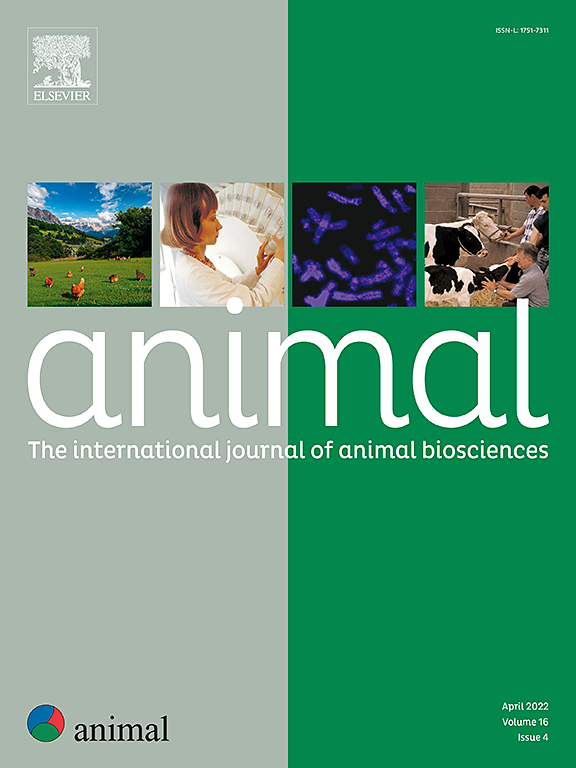The effect of protease supplementation in broiler chicken diets containing maize from different batches on growth performance and nutrient digestibility
IF 4
2区 农林科学
Q1 AGRICULTURE, DAIRY & ANIMAL SCIENCE
引用次数: 0
Abstract
Maize is the primary energy source in poultry diets. Nutritional and physical traits related to maize composition can affect nutrient utilization, as well as the efficacy of exogenous enzymes. A study was conducted to evaluate the effect of maize from different batches and protease supplementation on growth performance and ileal nutrient digestibility of broiler chickens from 1 to 40 days of age. A total of 1 920-day-old Ross 308 male chicks were assigned in a complete randomized design distributed into a 2 × 2 factorial arrangement comprising maize from two different batches (A and B) without and with protease (0 and 200 g/t), totaling 4 treatments and 12 replicates of 40 broiler chickens each. Experimental diets were divided into starter, grower I, grower II, and finisher phases. Both maize types were analyzed for nutritional composition, hardness, and structural differences in the starch granules via scanning electron microscopy. Feed intake, weight gain (WG), and feed conversion ratio (FCR) were evaluated. Ileal digesta was collected at 35 days to determine the apparent ileal digestibility (AID) of DM, CP, and ileal digestible energy (IDE). Hardness was higher in maize grains from batch A (P < 0.05), which may be associated with the denser and compact starch granules observed in electron microscopy. Broiler chickens fed maize from batch B and supplemented with protease showed greater WG and better FCR from 9 to 19 days (P < 0.05). From 1 to 40 days, birds fed the maize B diet had greater WG and lower FCR compared to those fed the maize A diet (P < 0.05). In the total period, protease supplementation reduced FCR (P < 0.01). No differences were found for AID of DM and CP, but broilers fed maize B diets had greater IDE (P < 0.05). In conclusion, although nutrient ileal digestibility was unaffected by treatments, the use of maize B led to superior growth performance and energy utilization due to its softer endosperm and starch composition, and protease supplementation reduced FCR and increased IDE regardless of maize batch.
在含有不同批次玉米的肉鸡日粮中添加蛋白酶对生长性能和营养物质消化率的影响
玉米是家禽日粮中的主要能量来源。与玉米成分相关的营养和物理特性会影响营养物质的利用以及外源酶的功效。本研究旨在评估不同批次的玉米和蛋白酶补充剂对 1 至 40 日龄肉鸡生长性能和回肠营养消化率的影响。采用完全随机设计法,将 1 920 日龄的 Ross 308 雄性雏鸡分配到 2 × 2 因子排列中,包括不添加蛋白酶(0 克/吨)和添加蛋白酶(200 克/吨)的两个不同批次(A 和 B)的玉米,共 4 个处理和 12 个重复,每个重复 40 只肉鸡。实验日粮分为开食期、生长期 I、生长期 II 和育成期。通过扫描电子显微镜分析了两种玉米的营养成分、硬度和淀粉颗粒的结构差异。对饲料摄入量、增重(WG)和饲料转化率(FCR)进行了评估。在 35 天时收集回肠消化物,以测定 DM、CP 和回肠可消化能量(IDE)的表观回肠消化率(AID)。批次 A 的玉米粒硬度较高(P
本文章由计算机程序翻译,如有差异,请以英文原文为准。
求助全文
约1分钟内获得全文
求助全文
来源期刊

Animal
农林科学-奶制品与动物科学
CiteScore
7.50
自引率
2.80%
发文量
246
审稿时长
3 months
期刊介绍:
Editorial board
animal attracts the best research in animal biology and animal systems from across the spectrum of the agricultural, biomedical, and environmental sciences. It is the central element in an exciting collaboration between the British Society of Animal Science (BSAS), Institut National de la Recherche Agronomique (INRA) and the European Federation of Animal Science (EAAP) and represents a merging of three scientific journals: Animal Science; Animal Research; Reproduction, Nutrition, Development. animal publishes original cutting-edge research, ''hot'' topics and horizon-scanning reviews on animal-related aspects of the life sciences at the molecular, cellular, organ, whole animal and production system levels. The main subject areas include: breeding and genetics; nutrition; physiology and functional biology of systems; behaviour, health and welfare; farming systems, environmental impact and climate change; product quality, human health and well-being. Animal models and papers dealing with the integration of research between these topics and their impact on the environment and people are particularly welcome.
 求助内容:
求助内容: 应助结果提醒方式:
应助结果提醒方式:


